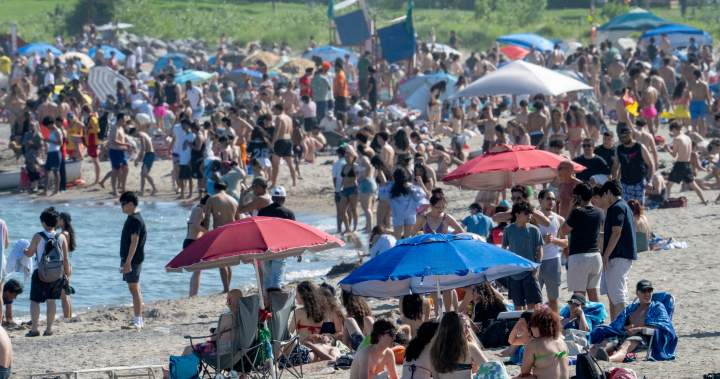Human-caused climate change made several heat waves across Canada two to 10 times more likely, Environment and Climate Change Canada said Wednesday.
The agency said summer 2025 was the 11th warmest on record and, while not “exceptional,” was warmer than the average since 1948.
“The strongest event, the most extreme event of the summer was observed in Atlantic Canada, which we found to be at least 10 times more likely because of human-induced climate change,” said Nathan Gillett, a research scientist with Environment and Climate Change Canada.
Environment and Climate Change Canada analyzed data from 17 regions of the country this summer when temperatures during a heat wave exceeded the typical hottest day of the year. For July and August, 10 met that threshold.
Nine of the hottest heat waves were seen in the Yukon, Northwest Territories, British Columbia, Alberta and Quebec, with the results showing the events were at least two — and up to 10 — times more likely due to human-made climate change than compared to the late 19th century.
Atlantic Canada saw a heat wave that was at least 10 times more likely due to human-caused climate change, specifically on Aug. 13, according to the results.
A heat wave also hit Atlantic Canada in July, with the peak daily high hitting 25.6 C.
This summer, the system showed northern Quebec saw two heat waves in July and August, where the temperatures hit 7 C or higher above the normal daily high.
Fort Smith, N.W.T., saw an eight-day heat wave with the temperature soaring 10 C above the normal daily high.
Get daily National news
Get the day’s top news, political, economic, and current affairs headlines, delivered to your inbox once a day.
The longest heat event of the 10 they analyzed occurred in northern B.C. and lasted from Aug. 23 until Sept. 9, while the hottest event was on Aug. 11 in southern Quebec with a temperature of 29.3 C.
The rapid extreme weather event attribution system can simulate the weather systems of the late 1800s, before the impacts of human-made climate change became prominent, and compare them with what Canada is seeing today.
Scientists then analyze the data to determine the extent to which an increase in greenhouse gases in the atmosphere contributes to making such extreme weather events likely.
Determining how much human influence is increasing the likelihood of dangerous weather extremes can help policymakers plan for, respond to and rebuild after emergencies, Gillett told reporters Wednesday.
According to a report last year by the Intact Centre on Climate Adaptation found between 1983 and 2008, insurance losses in Canada averaged $456 million a year. Since 2008, losses have surged and now regularly exceed $2 billion per year, mostly due to water-related damage from extreme flooding. The report pointed to flooding, wildfires and extreme heat as risks associated with climate change.
The extreme weather event system is also being expanded to analyze extreme precipitation and cold events, Gillett said.
He said human influence is causing extreme cold events to occur less, while higher than normal precipitation is happening more frequently and intensely, which scientists want to examine.
With the results come the ability to better prepare for human-based climate change events, but also make it easier to show the public it’s happening, said Anabela Bonada, managing director of climate science at the Intact Centre for Climate Adaptation.
“When we can attribute, which is what these attribution studies do, we can attribute an event to climate change, then it makes it real for us,” Bonada said. “We can communicate it to the public more clearly so they understand what they need to prepare.”
Atlantic Canada seeing a heat wave that is 10 times more likely due to human-induced climate change stresses the need for places across the country to prepare for extreme heat, Bonada said.
“That’s what’s happening with climate change, it’s a never-say-never kind of situation,” she said. “It affects areas of the country and the world that had not been affected before by certain kinds of weather.”
She noted various parts of the country are seeing “extreme” effects from climate change, including drought in Atlantic Canada, making it difficult for the agricultural industry.
High temperatures, she noted, were also causing wildfire risk to southern Ontario — in July and August, the province saw wildfires in parts of the Kawarthas near Toronto and near Huntsville.
“So areas of the county that don’t usually see wildfire, don’t see drought, and drought leads to wildfire, should start to expect that it could happen,” she said. “So that’s what climate change is doing for us.”
—with files from Global News’ Heather Yourex-West and The Canadian Press
© 2025 Global News, a division of Corus Entertainment Inc.
Human-made climate change made 10 summer heat waves more likely: experts


